What is the Best Fertilizer for your Morning Glory?
With so many types of morning glory and as many fertilizers as you can count, this can be a difficult question to answer.
This does not have to be a tough question anymore. This article will provide you with the Ultimate Guide to the 10 BEST Morning Glory Fertilizers.
And I recommend scrolling to the bottom of this page to find answers to the 10 most Frequently Asked Questions about fertilizing morning glory.
10 BEST Morning Glory Fertilizers
#1. Bayer Advanced Rose & Flower Care
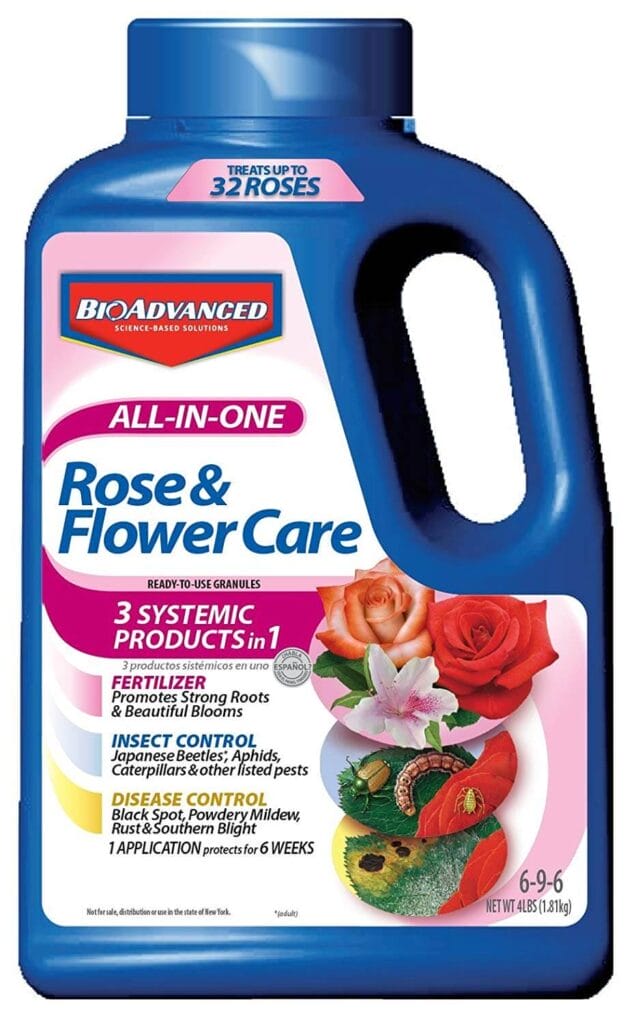
- Fertilizer Type: Granular
- NPK Ratio: 6-9-6
- Benefits: Works for 6 weeks, 3 in 1 product, treats up to 32 flowers
The Bayer Advanced Rose & Flower Care is the best Morning Glory Fertilizer on the market for Roses, Hibiscus, Irises, & so many more plants.
It is a 3 in 1 product that acts as insect control, disease control, and fertilizer.
Some of the insects that it controls are aphids, Japanese Beetles, Lacebugs, Mealybugs, Whiteflies, and Thrips. And it controls black spot, powdery mildew, blight, and rust.
Also, it works up to 6 weeks and treats up to 32 roses.
#2. JR Peters Jack’s Classic Blossom Booster
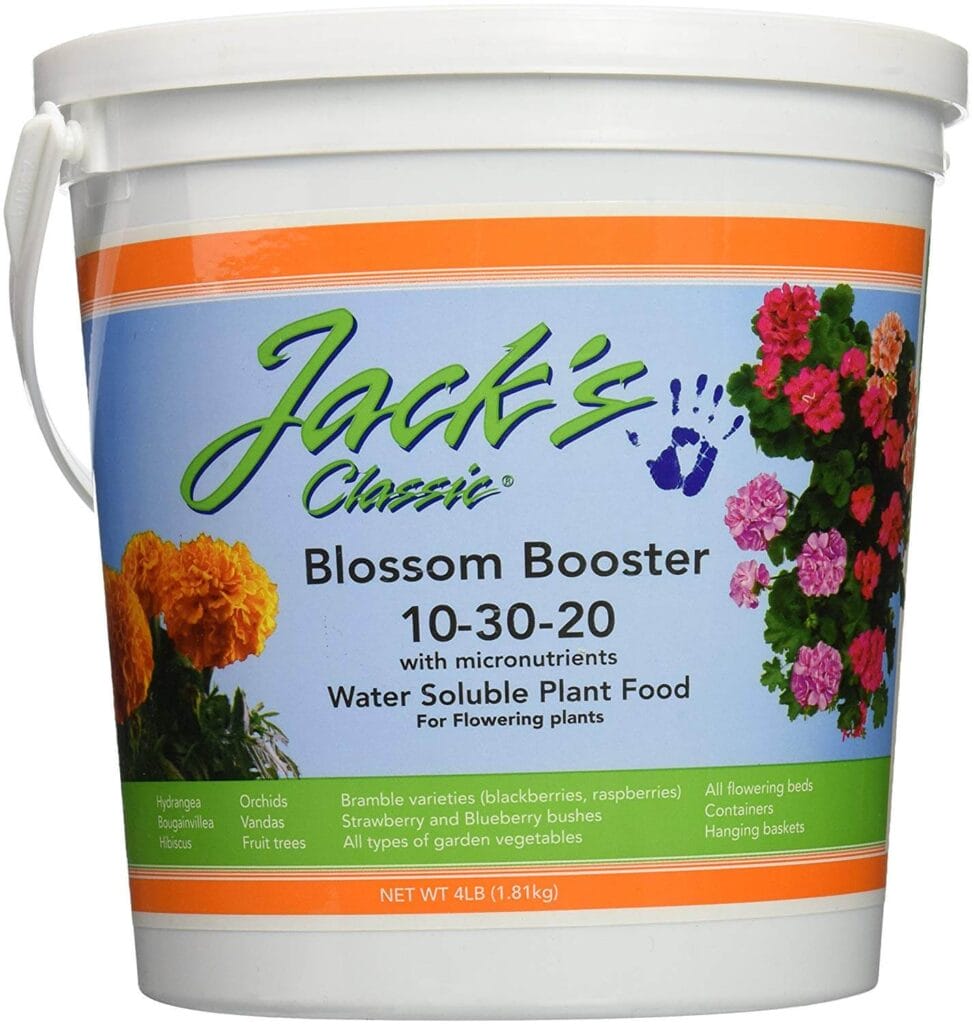
- Fertilizer Type: Water Soluble
- NPK Ratio: 10-30-20
- Benefits: Measuring Spoon, Highest safety factor
The JR Peters Jack’s Classic Blossom Booster is another great option for fertilizing your morning glory.
It feeds your morning glory through both roots and leaves. This is perfect for preventing burning.
It is made with a micronutrient package with optimal nutrition. This makes it perfect for strong roots and green foliage.
#3. Miracle-Gro Plant Food
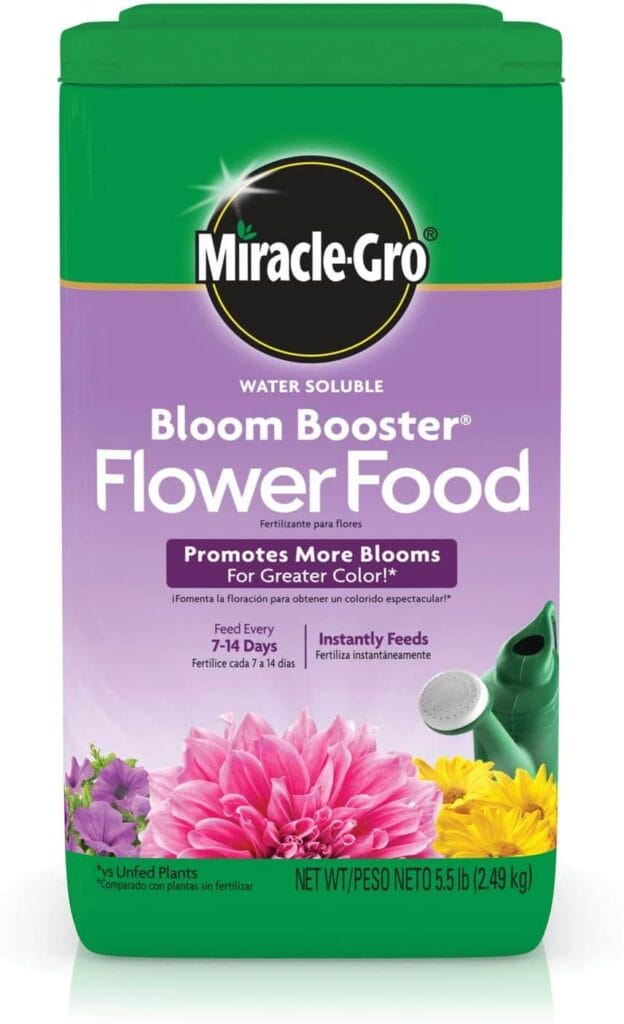
- Fertilizer Type: Water Soluble
- NPK Ratio: 18-18-21
- Benefits: Better Blooms, More Colorful Blooms, Easy to Use
If you go to any farm or farmer’s market the only type of fertilizer they will recommend using is this water-soluble solution by miracle-gro.
What sets this fertilizer apart from competitors is that it works instantly for both annual and perennial flowers.
Not only this, but it is reasonably priced, can be used in a large area, and can be applied every week without damaging your morning glory.
#4. Down to Earth Organic Rose & Flower Fertilizer
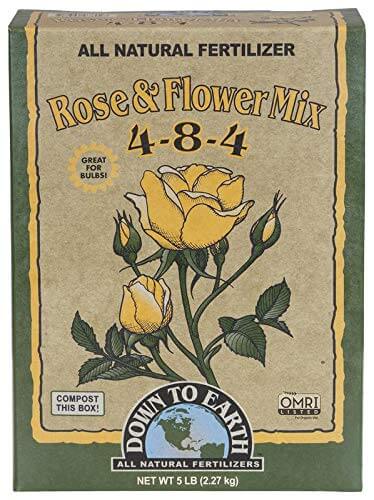
- Fertilizer Type: Organic/Granular
- NPK Ratio: 4-8-4
- Benefits: Little Needed, Organic
Down to Earth Organic Rose & Flower Fertilizer is the perfect blend of nitrogen for vigorous growth, extra phosphorus for beautiful blooms, and potassium for healthy plant stock.
This fertilizer is made of fishbone meal, langbeinite, blood meal, alfalfa meal, and kelp meal.
Best of all is that it can be used for edible bulbs, roses, annuals and perennials.
#5. Dr. Earth Total Advantage Rose & Flower Fertilizer
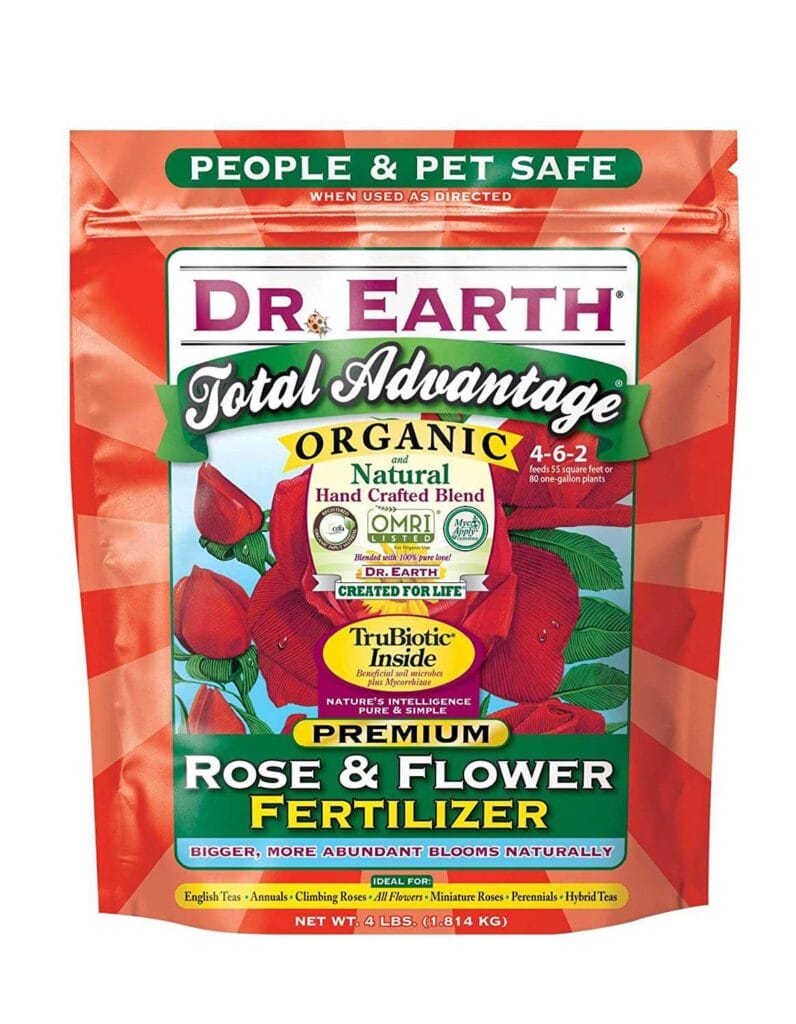
- Fertilizer Type: Organic/Granular
- NPK Ratio: 4-6-2
- Benefits: Made in the USA, People & Pet Safe
Dr. Earth Total Advantage Rose & Flower Fertilizer is a Non-GMO fertilizer made in the USA.
This fertilizer is people and pet safe.
It is made from human and feed grade ingredients, such as multi-minerals, proteins, and carbohydrates.
This is a perfect fertilizer for Morning Glory, English Teas, Annuals, Climbing Roses, All Flowers, Mini-Roses, and Perennials.
#6. Miracle-Gro Shake N Feed Rose & Bloom
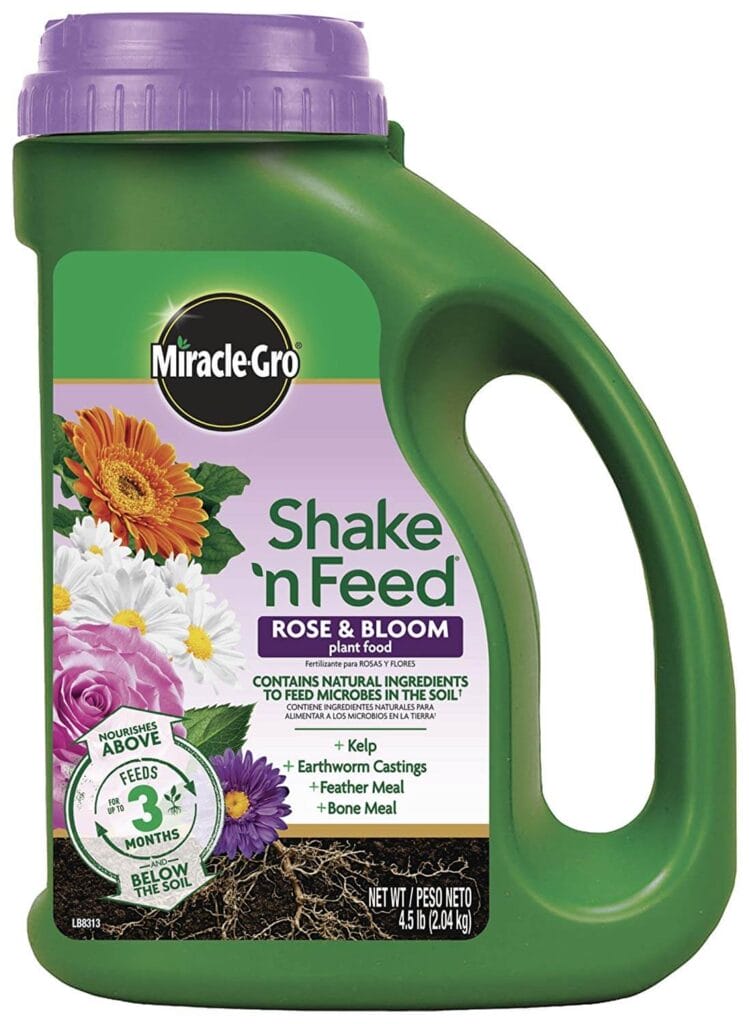
- Fertilizer Type: Granular
- NPK Ratio: 10-18-9
- Benefits: Feeds up to 3 months, takes the guesswork out of feeding
Miracle-Gro Shake N Feed Rose & Bloom Fertilizer is perfect for beginner fertilizers and gardeners.
What makes this product stand out is that it comes pre-measured, taking the guesswork out of feeding.
This is perfect for new and healthy roses. It is made of natural ingredients like kelp, bone meal, and earthworm castings.
#7. Jobe’s Organics Rose & Flower Fertilizer
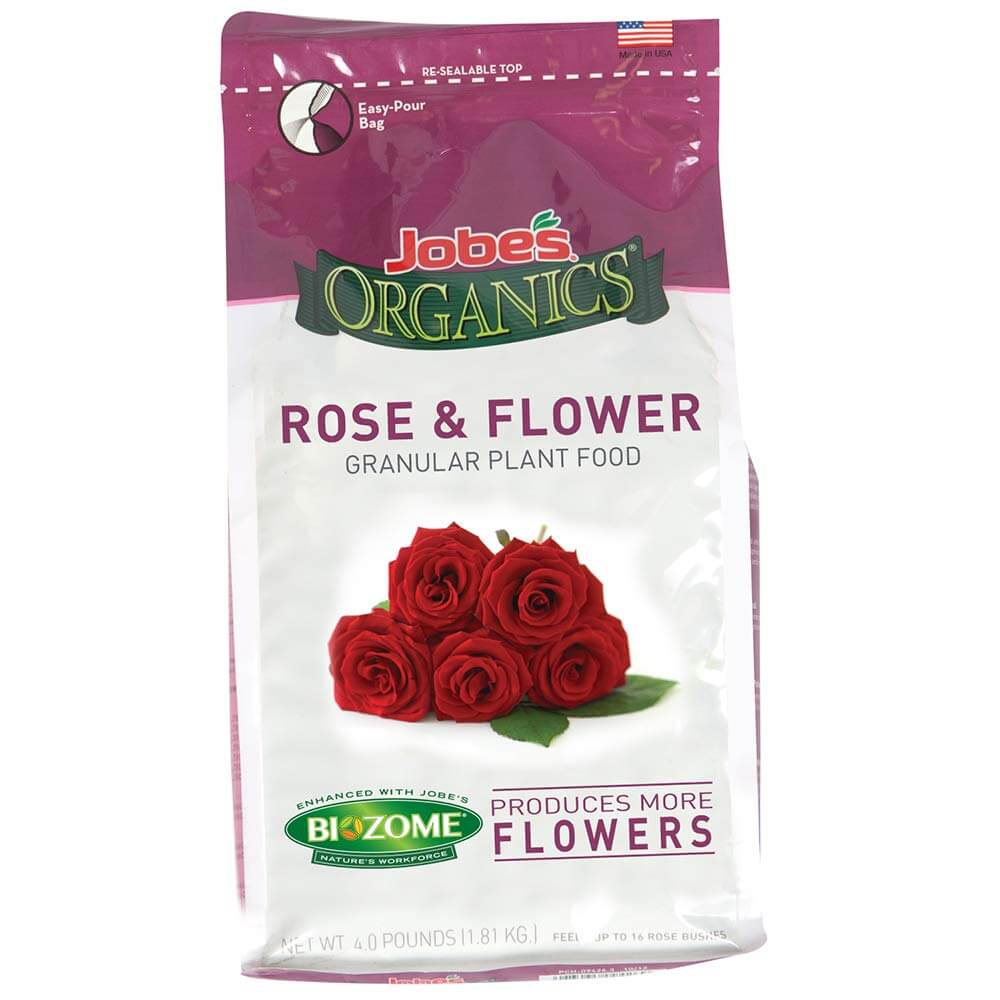
- Fertilizer Type: Granular
- NPK Ratio: 3-5-3
- Benefits: Kid & Pet-Friendly, Improves Soil Quality, Fast-Acting
Jobe’s Organics Rose & Flower Fertilizer is an organic and fast-acting fertilizer.
This is a pet and kid-friendly fertilizer.
Best of all is that it is made with proprietary biozone microorganisms that improves soil quality and nutrient absorption.
#8. Espoma Rose Plant Food
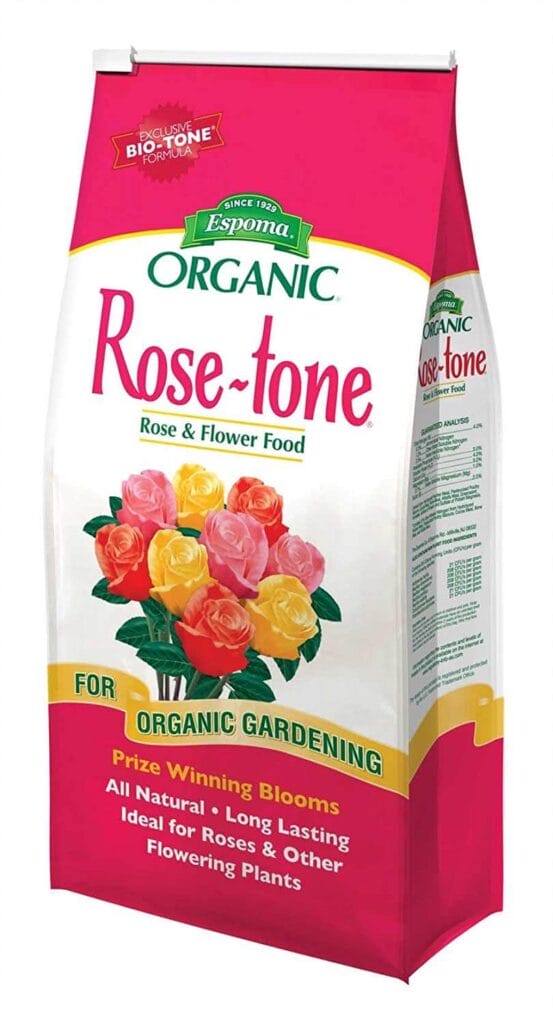
- Fertilizer Type: Organic/Granular
- NPK Ratio: 4-3-2
- Benefits: Made in USA, Safe, Organic
Espoma Rose Plant Food is natural and organic with thousands of microbes in it.
This fertilizer is made in the USA and is safe for both humans and the environment.
What you’ll love most about this product though is that it contains all 15 essential nutrients needed for morning glory to grow and bloom bigger than ever!
#9. Osmocote Smart-Release Flower Food
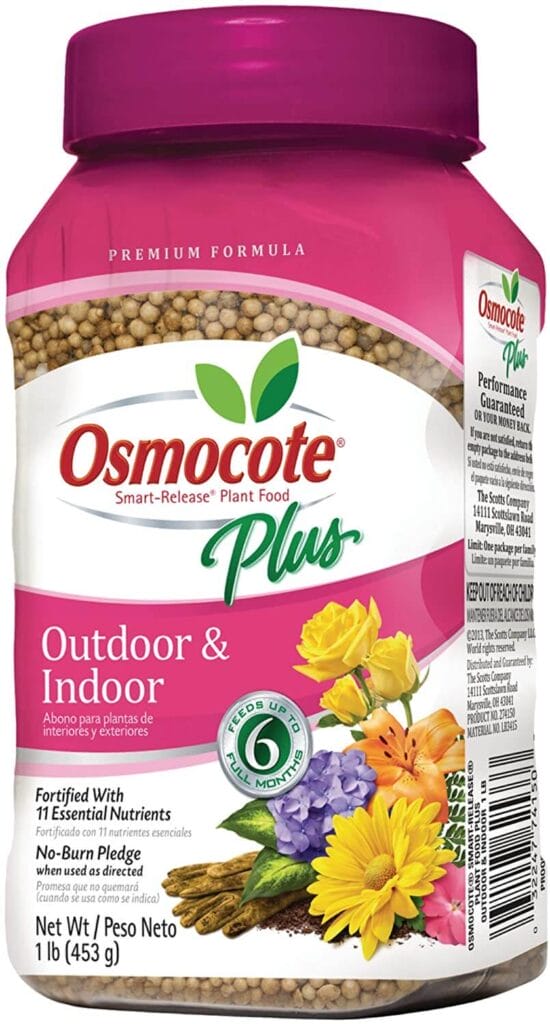
- Fertilizer Type: Water-Soluble
- NPK Ratio: 15-9-12
- Benefits: Works for all morning glory, perfect for indoor fertilizing, only need to apply twice a year
Osmocote is one of the most popular and well-respected fertilizer brands and when it comes to morning glory fertilizers you can’t go wrong with this plant food.
What you’ll love about this product is that it is easy for beginner morning glory gardeners. All you need to do is apply it once every 6 months. That’s it!
Not only this, but it works with all morning glory, indoors, outdoors, and even in gardening containers.
#10. EZ-Gro Flower Food
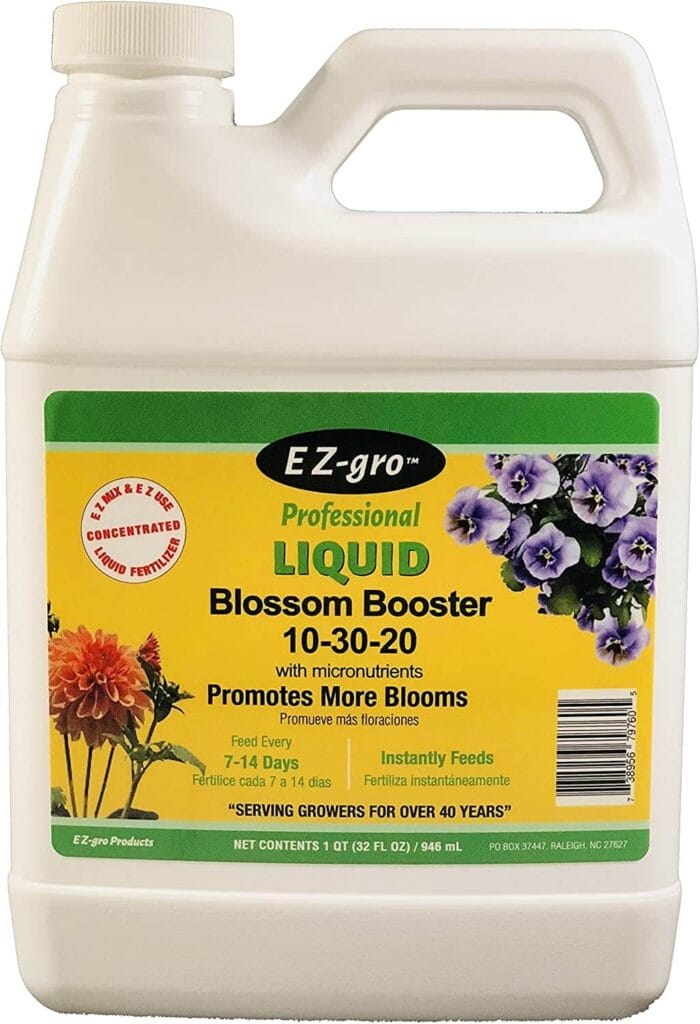
- Fertilizer Type: Water-Soluble/Liquid
- NPK Ratio: 10-30-20
- Benefits: Versatile, Instant-Feed, Contains more micronutrients than competitors
You may not have heard of EZ-Gro, but there is a reason it gets almost 5 stars on Amazon. This fertilizer works!
What sets this product apart from competitors is that it instantly feeds your morning glory, increases morning glory buds, and contains more micronutrients than any other fertilizer.
Not only that, but this fertilizer is versatile and can be used with indoor morning glory plants and for any morning glory planted anywhere in your yard or garden.
Frequently Asked Questions
#1. What Nutrients Do Morning Glory Need?
Morning Glory need 3 main nutrients to grow and blossom.
- Nitrogen (N) – This helps with root and steam growth and provides a firm base for the plant
- Phosphorus (P) – This helps with roots absorbing nutrients better
- Potassium (K) – This protects morning glory against diseases and helps with morning glory color.
Morning Glory also need:
- Magnesium – Helps plants better process sunlight
- Sulfur – Provides morning glory with additional protein, which is needed for a strong life.
- Iron – Helps Morning Glory have a strong base.
- Manganese – Helps morning glory growth and process of sunlight.
2. What is a NPK Ratio?
NPK stands for the ratio of Nitrogen to Phosphorus to Potassium.
Typically, morning glory need 3 pounds of nitrogen per 1,000 square feet.
For almost all morning glory you will want a fertilizer with a 10-10-10 or 5-10-10 NPK ratio.
3. How Do I Choose a Morning Glory Fertilizer?
Choosing Morning Glory Fertilizer will depend on what you want them to do.
- Bloom Boosting Fertilizer – This is good for blooming morning glory that die after a short amount of time.
- Strengthening Fertilizer – This is good for morning glory not budding. This will help morning glory absorbing water.
- Organic – This will not only help your morning glory but the soil around it.
4. How Do I Fertilize Morning Glory?
If you want to fertilize morning glory there are several important tips you should follow:
- First, use a pH tester to ensure your soil is between 6.0-6.5
- Apply fertilizer according to the instructions on the label
- Use only water-soluble or liquid fertilizer and apply more frequently
- Use only liquid fertilizer for smaller morning glory.
- Watch the below video on how to fertilize morning glory
5. When Should I Fertilize Morning Glory?
When you should fertilize morning glory depends on the morning glory you grow (annual or perennial), when the morning glory blooms, and the fertilizer you use.
- Always read the instructions for best use!
- Begin fertilizing when your morning glory after new green growth emerges from the ground or plant, but before flower buds begin.
- Apply fertilizer to your morning glory approximately 2 weeks after your last frost or right after new growth emerges.
- Stop fertilizing once flowers bloom and petals begin to fall.
6. How Often Should I Fertilize My Morning Glory?
How often you should fertilize your morning glory depends on the fertilizer and soil.
- During the growing season (before morning glory buds appear) fertilize every 4 to 6 weeks.
- After your morning glory blooms and once petals begin to fall from the plant you should stop fertilizing.
Slow-Release Fertilizer does not need to be applied as much. Also, you do not need to apply fertilizer as frequently to loamy soil.
In addition, organic fertilizer does not need to be applied as much.
Liquid fertilizers should be applied weekly. You should also apply fertilizer more if you have sandy soil.
Finally, rotate your fertilize throughout the flower gardening season. This will provide the right amount of nutrient mix. Using only one fertilizer can potentially build up too much of one nutrient which will destroy your morning glory.
7. How Do I Know if My Morning Glory Need Fertilizer?
You will know if your morning glory need fertilizer if you observe one of the following:
- Yellow leaves, no new growth, and small pale flowers mean your morning glory plants need nitrogen
- Dull foliage, falling leaves, and weak flower buds means your morning glory need phosphorus
- Weak stems, poor buds, yellow edges on leaves, or brown leaves means your morning glory need potassium
8. What Alternatives to Fertilizers Can I Apply to Morning Glory?
If you do not want to use retail or commercial flower fertilizers then you can use the below alternatives. These alternatives will not only help your plant but the soil around it:
- Epsom Salt
- Kelp Meal
#9. What are the Different Types of Garden Fertilizer?
A) Granular
Granular fertilizer is a dry fertilizer that can be applied with a spreader.
One of the benefits of this type of fertilizer is that you can see the actual fertilizer. You can also see where you have applied it and where it needs to be applied.
This type of fertilizer can be slow-release or quick-release.
Slow-Release fertilizer releases nutrients steadily over an extended period of time. This means you only have to fertilize once or twice a year.
Quick-Release delivers nitrogen immediately.
B) Liquid
Another type of fertilizer for your garden is liquid fertilizer.
Liquid fertilizer needs to be diluted before it can be applied. It can be applied using a canister, hose, or a watering can.
It is easy to apply and is quickly absorbed.
C) Spikes
The final type of fertilizer that can be applied to your garden is spikes.
Spikes are fertilizer in the shape of sticks. This is a slow-release fertilizer meaning it will be released over time. It is directly inserted into the ground!
This is perfect for beginning gardeners.
#10. What’s the Difference Between Organic and Synthetic Fertilizer?
My next tip for deciding on the Best Gardening Fertilizer is simple:
- Buy either organic or synthetic fertilizer.
Synthetic fertilizer releases nutrients quickly
- This type of fertilizer comes in liquid, granular, or spikes.
Organic fertilizer releases nutrients slowly.
- It typically is not concentrated meaning that the odds of killing plants are much less.
Below, are my three favorite organic fertilizers.
Jobe’s Organic All Purpose Fertilizer
Conclusion
As a reminder
- All morning glory should be fertilized throughout the year. Make sure you read the instructions and apply them as needed.
- There are three types of flower fertilizers; Granular, Liquid, and Spikes. Each one meets the different needs of a gardener and you may have to use all three.
- Organic is a great flower fertilizer to be used if you want to improve soil quality and plant quality.
- I recommend getting your soil tested, deciding to use organic or synthetic, and what type of NPK mix you need.
- Any of the above 10 fertilizers are great options. All are reasonably priced, easy to use, and can dramatically improve your morning glory plant growth and blooms.
- If you want the best success with fertilizing your morning glory then use several different kinds. Rotate these fertilizers throughout the year for the best success.
- If you would like to use alternatives to commercial fertilizer then purchase Kelp Meal, Alfalfa Meal, or Epsom Salt.
What’s Next?
If you like this article then I highly recommend reading:
Best Raised Garden Beds for ALL Plants

